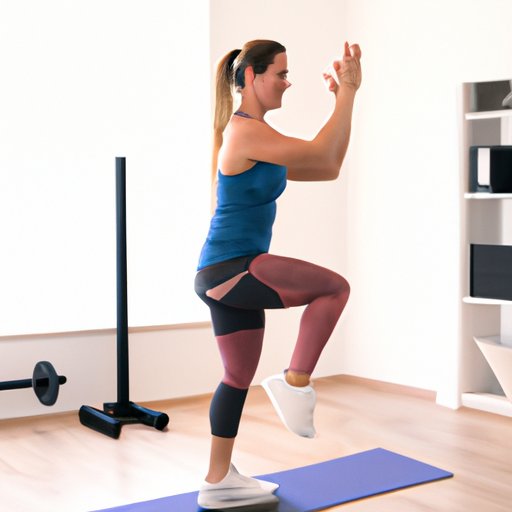Introduction
With so many workout programs and exercise routines available, it can be challenging to choose the best one that fits your preferences, needs, and goals. However, regardless of your fitness level or objectives, understanding functional exercises can significantly improve your workouts and overall fitness performance.
Explanation of the Problem
The traditional approach to exercise focuses on stationary, repetitive movements that isolate specific muscle groups. While this method can provide short-term benefits regarding muscle growth and strength, it often neglects the body’s natural movement patterns while increasing the risk of injury and limiting mobility and flexibility.
Importance of Understanding Functional Exercises
Functional exercises, on the other hand, are designed to mimic real-life movement patterns and optimize overall fitness performance, rather than merely building muscle and strength. These exercises can help you recover from injuries, reduce the risk of future injuries, and improve your quality of life by enhancing your strength, endurance, and mobility.
Thesis Statement
In this article, we provide the ultimate guide to understanding functional exercises by exploring their definition, key principles, science behind them, benefits, and techniques.
The Ultimate Guide to Understanding Functional Exercises
Definition of Functional Exercises
Functional exercises are movements that enable individuals to perform activities of daily living more efficiently and safely. These exercises focus on specific muscle groups while utilizing a wide range of movements intended to challenge and strengthen muscle imbalances and overall fitness performance.
Key Features and Principles of Functional Exercises
The key features and principles of functional exercises include the following:
- Multi-joint and multi-planar movements: Exercises that involve movements in different directions and utilize multiple joints promote overall fitness performance while reducing the risk of injury.
- Progressive overload: To achieve maximum benefits from functional exercises, it’s essential to gradually increase the intensity, duration, and frequency of workouts so that the body can adapt to new challenges.
- Core stabilization: Core stabilization is essential to maintaining proper form and technique while performing functional exercises.
- Balance and symmetry: Functional exercises promote balance and symmetry by developing equal strength and endurance in both sides of the body, enhancing posture, and reducing the risk of injury.
- Integration of movement patterns: Functional exercises aim to integrate various movement patterns into the workout routine to optimize fitness performance and enhance daily living
How Functional Exercises Differ from Traditional Exercises
The fundamental difference between functional exercises and traditional exercises is that functional exercises involve multi-joint movements that mimic real-life movements while traditional exercises typically involve isolated movements that focus on one muscle group at a time. Additionally, functional exercises aim to optimize overall fitness performance rather than muscular growth and strength alone.
Examples of Functional Exercises
There are various examples of functional exercises designed to promote overall fitness performance, including squats, lunges, deadlifts, push-ups, pull-ups, planks, and burpees.
Functional Exercises: What They Are and Why They Matter
The Science behind Functional Exercises
Functional exercises are based on the notion that all movement patterns involve a chain reaction of muscle groups that require coordination and balance. These exercises aim to develop the neuromuscular system by engaging muscles to work together rather than in isolation.
How Functional Exercises Improve Overall Fitness
Functional exercises improve overall fitness by enhancing strength, endurance, flexibility, and mobility. These exercises also improve balance, coordination, and agility, which are particularly beneficial for athletes and active individuals.
How Functional Exercises Help Avoid Workout Plateaus
Functional exercises can help avoid workout plateaus by challenging the body in new ways, using different movements, equipment, and routines to prevent muscle memory. This aspect of functional exercises also makes them highly adaptable to different fitness levels and preferences.
The Role of Functional Exercises in Sports and Daily Life
Functional exercises play a crucial role in sports and daily life by promoting overall fitness performance and reducing the risk of injury. Athletes often use functional exercises to improve coordination, balance, and agility, while older adults may use them to maintain mobility and reduce the risk of falls.
Transform Your Workout with These Functional Exercises
Warm-up Exercises
Dynamic warm-up exercises can prepare your body for functional exercise routines by increasing heart rate, blood flow, and body temperature. Examples of warm-up exercises include leg swings, arm swings, jumping jacks, and high knees.
Resistance Exercises
Resistance exercises that utilize free weights, resistance bands, or bodyweight can challenge muscle groups to work together while promoting strength, endurance, and balance. Examples of resistance exercises include squats, lunges, deadlifts, and push-ups.
Cardio Exercises
Cardio exercises such as running, biking, or swimming can improve endurance, agility, and overall fitness performance. Including cardio exercises in your functional exercise routine can help you burn calories and maintain a healthy weight while reducing the risk of injury.
Cool-down Exercises
Cool-down exercises can help reduce the risk of injuries and maintain proper recovery after workout routines. These exercises involve stretching, foam rolling, and low-intensity movements intended to promote relaxation and muscle recovery.
The Benefits of Incorporating Functional Exercises into Your Fitness Routine
How Functional Exercises Help with Weight Loss
Functional exercises can help with weight loss by promoting muscle growth, burning calories, and increasing metabolism. These exercises also promote healthy eating habits, which can help you maintain a healthy weight and lifestyle.
How Functional Exercises Promote Muscle Growth and Development
Functional exercises promote muscle growth and development by utilizing compound movements that challenge multiple muscle groups together. These exercises can also increase testosterone and human growth hormone production, promoting muscle growth and development.
How Functional Exercises Enhance Flexibility and Mobility
Functional exercises enhance flexibility and mobility by promoting the neuromuscular system’s development and improving range of motion and joint mobility. These exercises can also reduce the risk of injuries and improve posture.
How Functional Exercises Improve Mental Health
Functional exercises improve mental health by promoting the release of endorphins, reducing stress levels, and improving cognitive function and memory. These exercises can also boost self-esteem, confidence, and overall mood.
Functional Fitness: Taking Your Workout to the Next Level
Real-life Examples of Functional Fitness
Real-life examples of functional fitness include activities such as hiking, cycling, swimming, and even household chores, such as gardening, cleaning, and carrying groceries. These activities promote overall fitness performance and can provide an enjoyable way to incorporate functional exercise into your daily routine.
Importance of Using Proper Form and Technique
Using proper form and technique during functional exercise routines is crucial to prevent injury and maximize benefits. It’s essential to maintain stability, balance, and symmetry while engaging muscle groups to work together effectively.
How to Progress and Adjust Functional Exercises
Progressively increasing the intensity, duration, and frequency of functional exercise routines can help the body adapt to new challenges. It’s also crucial to adjust functional exercises to meet your fitness level, goals, and preferences, such as incorporating different equipment or modifying movements.

How to Build Strength and Improve Balance with Functional Exercises
The Role of Functional Exercises in Building Strength and Enhancing Balance
Functional exercises play a crucial role in building strength and enhancing balance by improving muscle coordination, neuromuscular control, and body awareness. These exercises promote balance and symmetry between both sides of the body while increasing overall strength and endurance.
Techniques to Improve Strength and Balance with Functional Exercises
Techniques to improve strength and balance with functional exercises include using unstable surfaces, incorporating plyometric exercises, adding resistance to exercises, and focusing on unilateral movements.
The Importance of Rest and Recovery in Functional Fitness
The body requires rest and recovery to repair and regenerate muscle tissue in response to functional exercise. Focusing on recovery techniques such as foam rolling, stretching, and massage can speed up recovery and prevent injuries.
Functional Exercises: The Key to Preventing Injuries and Maintaining Mobility
How Functional Exercises Improve Flexibility and Mobility
Functional exercises improve flexibility and mobility by promoting joint mobility, range of motion, and muscle coordination. These exercises also reduce the risk of injuries by improving posture and balance.
How Functional Exercises Reduce the Risk of Injury
Functional exercises reduce the risk of injury by promoting joint stability, muscular balance, and overall fitness performance. These exercises also improve neuromuscular control, preventing falls and other injuries.
Tips for Integrating Functional Exercises into Recovery Workouts
- Start slow with light weights and low-intensity exercises.
- Incorporate stretching and foam rolling to promote muscle recovery and relaxation.
- Focus on exercises that promote balance, coordination, and mobility.
- Adjust exercises to meet your fitness level and recovery needs.
Conclusion
Recap of the Key Points
Functional exercises are movements that promote overall fitness performance by mimicking real-life movements and challenging different muscle groups to work together. These exercises utilize multi-joint movements and progressive overload to enhance strength, endurance, flexibility, and mobility.
Importance of Incorporating Functional Exercises into Your Fitness Routine
Incorporating functional exercises into your fitness routine can significantly improve your fitness performance, reduce the risk of injury, and enhance your overall quality of life. Functional exercises promote strength, balance, agility, and mobility, making them suitable for athletes, older adults, and individuals with different fitness levels and preferences.
Final Thoughts and Recommendations
To get the most out of functional exercises, focus on proper form and technique, progressively increase the intensity and frequency of workouts, and incorporate balance and mobility exercises. Additionally, ensure to include recovery techniques such as stretching, foam rolling, and rest to prevent injury and optimize benefits.
(Note: Is this article not meeting your expectations? Do you have knowledge or insights to share? Unlock new opportunities and expand your reach by joining our authors team. Click Registration to join us and share your expertise with our readers.)
